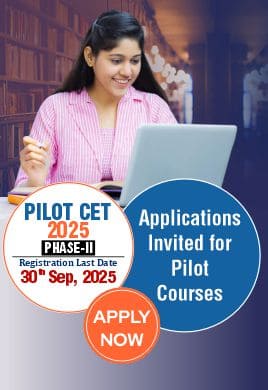.jpg)
Pilot Eligibility for Female
Aviation industry is a very progressive career field that equally welcomes both male and female aspirants. In India, the Directorate General of Civil Aviation (DGCA) ensures that there are no separate rules or restrictions for women. There is no difference in the eligibility requirements in terms of education, age and medical fitness between the two genders, and this serves as a level playing field. This inclusivity has made India one of the leading countries with a high population of women pilots in commercial airlines, which demonstrates that aviation opportunities are founded on merit, skills and determination and not gender.
Requirements for Female Pilot Aspirants
DGCA provides equal opportunities to both male and female students. Female aspiring pilots have to meet the same qualification, medical standards and skill requirements as their male counterparts. Here are the key criteria:
| Criteria | Details for Female Candidates |
|---|---|
| Educational Qualification |
Must have passed 10+2 with Physics, Chemistry and Mathematics (PCM) from a recognized board. Equivalent qualifications like NIOS or international boards are accepted if verified by DGCA. |
| Age Requirement |
Minimum 17 years for Student Pilot License (SPL). Minimum 18 years for Commercial Pilot License (CPL). |
| Medical Fitness |
Must clear Class 2 Medical (for SPL) and later Class 1 Medical (for CPL) conducted by DGCA-approved examiners. Includes eyesight, hearing, cardiovascular health and overall fitness. |
| Height & Physical Standards |
Minimum height usually 152 cm (5 feet), may vary slightly depending on training aircraft. No strict weight limit, but BMI must be within healthy range. |
| Nationality |
Indian citizens and OCI card holders can apply, as per DGCA norms. |
| Language Proficiency |
Must demonstrate English communication skills (ICAO Level 4 or above). |
| Exams & Licensing |
Must pass DGCA theory exams in Air Regulations, Navigation, Meteorology and Technical subjects before applying for CPL. |
| Other Considerations |
No gender-based restrictions. Female candidates enjoy equal opportunities to join airlines, cargo, private aviation or defense services (through NDA/AFCAT). |
Global Rules for Women Pilots
There is no difference in pilot eligibility rules between men and women all over the world. Women applicants are required to fulfill age, education, medical and hours of flying qualifications. Numerous countries have provided scholarships and diversity schemes to assist women in flight.
| Country | Minimum Age | Education | Medical Standard | Flying Hours |
|
USA (FAA) |
17 (PPL) |
High school diploma; Maths/Science preferred |
Class 3 (PPL), Class 2 (CPL), Class 1 (ATPL) |
40 (PPL) |
|
18 (CPL) |
250 (CPL) |
|||
|
23 (ATPL) |
1500 (ATPL) |
|||
|
Canada (Transport Canada) |
18 (CPL) |
High school diploma with Maths, English, Science |
Class 1 (CPL/ATPL) |
200 (CPL) |
|
21 (ATPL) |
1500 (ATPL) |
|||
|
Australia (CASA) |
17 (PPL) |
High school/VCE with Maths and English |
Class 2 (PPL), Class 1 (CPL) |
40+ (PPL) |
|
18 (CPL) |
200+ (CPL) |
|||
|
United Kingdom (CAA) |
17 (PPL) |
A-Levels with Maths/Physics (or equivalent) |
EASA Class 1 Medical |
200 (CPL) |
|
18 (CPL) |
1500 (ATPL) |
|||
|
United Arab Emirates (GCAA) |
18-29 (Cadet programs) |
High school diploma with Maths/Science, IELTS 5.5+ |
Class 1 Medical |
200 (CPL) |
|
1500 (ATPL) |
||||
|
South Africa (SACAA) |
17 (PPL) |
High school with Maths and Science preferred |
Class 1 Medical (CPL/ATPL) |
200 (CPL) |
|
18 (CPL) |
1500 (ATPL) |
Career Path for Female Pilots
For female aspirants, the journey to becoming a professional pilot follows the same structured licensing process as it does for male candidates, under DGCA guidelines
Student Pilot License (SPL):
- The first step in pilot training obtained at the age of 17 after clearing basic medical tests and an oral exam. It allows the students to begin flying training under the supervision of an instructor.
Private Pilot License (PPL):
- After initial flying hours female students can apply for PPL. This license allows them to fly aircraft for personal use and practice but not for commercial purposes. PPL helps in gaining experience and building confidence.
Commercial Pilot License (CPL):
- The most crucial step for those aiming to become professional pilots. With a CPL, female pilots can officially work with airlines, charter companies or cargo carriers. The minimum age is 18 and students must complete required flying hours and DGCA exams.
Airline Transport Pilot License (ATPL):
- The highest level of pilot certification for those aiming to become airline captains. With an ATPL, female pilots can officially command commercial aircraft and lead flight operations. The minimum age is 21 and candidates must complete 1,500 flying hours along with passing the DGCA , ATPL exams.
Job roles After CPL for Female Pilots
- Airline Pilot: Fly passenger aircraft for domestic and international airlines.
- Cargo Pilot: Operate cargo flights for logistics companies.
- Flight Instructor: Train and guide new pilot aspirants in flying schools.
- Corporate Pilot: Fly private jets for business executives or VIPs.
- Defense Pilot (via NDA/AFCAT): Join the Indian Air Force as a fighter or transport pilot after clearing defense-specific entrance exams.
Aviation today is no longer a male dominated field, female pilots are breaking barriers and inspiring the next generation. With DGCA and international authorities providing equal eligibility standards women now have the same platform to prove their skills. The future of aviation is inclusive and with growing opportunities worldwide, female pilots are set to soar higher than ever before.
Frequently Asked Questions
Commercial Pilot License Commercial Helicopter Pilot License Private Pilot License Private Helicopter Pilot License

